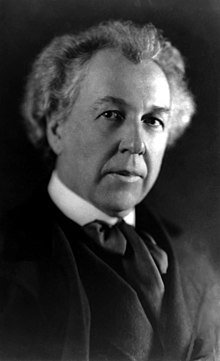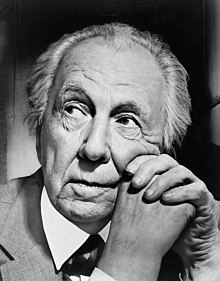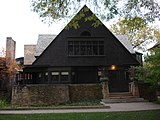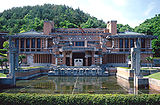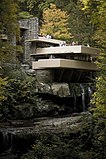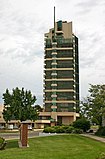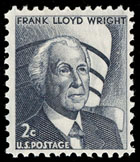Frank Lloyd Wright
Frank Lloyd Wright (born June 8, 1867 in Richland Center , Wisconsin , † April 9, 1959 in Phoenix, Arizona ) was an American architect , interior designer , writer and art dealer .
Life
Origin, education, employee
Wright grew up in rural Wisconsin and studied from 1885 at the University of Wisconsin , but left the University of Wisconsin without a degree in 1887 - he received an honorary doctorate from the university in 1955. As a result, he joined the architectural office of Joseph Lyman Silsbee in Chicago , left the company but that same year to work in Dankmar Adler and Louis Sullivan 's office.
Own company near Chicago
In 1893 he founded his own company in Oak Park , a suburb of Chicago, where he now lives . By 1901 he had worked on around 50 projects. Until around 1910 he mainly created so-called prairie houses . His employees included Walter Burley Griffin and his future wife Marion Mahony Griffin .
Principles of architecture
The close contact with the landscape of his home state Wisconsin was central to his later work: The seamless integration of the building into the landscape is one of the motifs of his immense work. This design philosophy is best demonstrated in Wright's most famous work, the Fallingwater villa built for Edgar J. Kaufmann on a small waterfall . Other well-known designs are the Solomon R. Guggenheim Museum in New York, realized in conjunction with Hilla von Rebay , and the administration building for the Johnson Wax Company .
After centuries of America's cultural dependence on the old continent, Wright wanted to establish an independent architecture for the new continent. His so-called Prairie Houses were supposed to be an expression of the American spirit of democracy, pioneering spirit and cohesion. The most important element was the fireplace as a meeting place for the community around which the building develops. The whole thing is harmoniously embedded in the surrounding landscape.
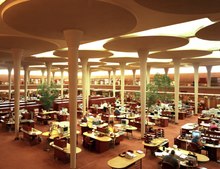
Wright was one of the first architects to use the term " organic construction ". He was concerned with an organic connection between architecture and the various elements of art, nature and areas of human life, i.e. less in a biological sense.
Under the name Taliesin , Wright founded several "studios" in the middle of the American prairie, which were to serve as development platforms for the new, independent American architecture. Wright's office attracted young architects from all over the world, who worked for him temporarily and later further developed his style in their home countries, including on the old continent such as Werner Max Moser , Bruce Goff was his student and the Austrian architect and Adolf -Loos- student Leopold Fischer , who emigrated to Los Angeles before the National Socialists in 1936 because of the Nuremberg Race Laws , worked with Frank Lloyd Wright from 1938 to 1940 on the recommendation of Arnold Schönberg. In 1937 Wright visited the USSR for 3 weeks
In his book When democracy builds (German 1950), published in 1945, Frank Lloyd Wright created a kind of utopian master plan for civilization in the 20th century.
"Usonia" ( Usonia ) is what Wright calls his visionary America. It consists of a new urban form he has devised: Broadacre City . Only here do people enjoy “true individuality” (and not “robust individuality” = egoism) in a real holistic democracy. The values of the Declaration of Independence are characteristic of this vision. Since all potential leaders (politicians, philosophers, artists, ...) would have failed, Usonia is led by an architect. The government only performs administrative tasks.
Wright felt friendship and fascination for the shimmering Caucasian esotericist Georges I. Gurdjieff , a charismatic wisdom teacher who was already controversially discussed in his day and whom he met through his third wife Olgivanna, who had been Gurdjieff's student in the 1920s.
Writer, art dealer
In addition to his work as an architect and writer, Wright also worked as an art dealer and collector. On his first trip to Japan in 1905, he acquired a large inventory of woodcuts of the ukiyo-e genre, which he used partly to furnish his own property and partly for profitable resale. After erecting the buildings he had planned, he was able to skillfully understand that the clients should also buy suitable art objects. At times, the income from the art trade was higher than from the work of architecture.
Honors
In contrast to all other great American architects of his time, Frank Lloyd Wright received only a few official honors or awards in the form of architecture prizes or honorary doctorates. His election as an associate member ( ANA ) of the National Academy of Design in 1952 and his membership since 1947 of the American Academy of Arts and Letters is documented. In 1953 he received the Gold Medal in Architecture from this academy.
In February 2015, ten Wright buildings were nominated for UNESCO World Heritage List . In July 2019, a modified list of eight buildings was declared a World Heritage Site. These are:
- Unity Temple in Oak Park , Illinois
- Frederick C. Robie House in Chicago , Illinois
- Taliesin in Spring Green, Wisconsin
- Hollyhock House in East Hollywood , Los Angeles, California
- Fallingwater in Mill Run, Pennsylvania
- Herbert and Katherine Jacobs First House in Madison , Wisconsin
- Taliesin West in Scottsdale , Arizona
- Solomon R. Guggenheim Museum in New York City
Wright's principles of organic architecture
- Simplicity and repose
- This principle should be authoritative for art. In order to achieve such qualities, everything should be eliminated that is not necessary. At Wright, this also means eliminating interior walls so that a house should have as few rooms as possible. Openings should be incorporated into the structure as a shape so that they become some kind of natural ornamentation. Detail and decoration should be reduced and household appliances, fixtures, pictures and furniture should also be integrated into the structure.
- There are as many styles of houses as there are people themselves
- This principle allowed the personalities of the respective client to be expressed, although the designs always bore Wright's signature. It also allowed him to deal with the eclectic style of historicism, which was also very popular with architects in North America in the 19th century. At the beginning of the 20th century, the question of the representation of a style faded into the background. The question to whom architecture should represent became more important; this increasingly means the values of society or an individual artist. Sullivan already emphasized the importance of connecting people and architecture.
- Correlation of nature, topography and architecture
- A building should appear as if it had grown out of its surroundings, it should harmonize with it. For example, a building should be designed as inconspicuous as possible in a flat landscape.
- The colors of nature
- The color spectrum of the surrounding nature should harmonize with the materials of the house. Here Wright applied the term “conventionalization”: a method that reduced the form to the essentials, namely color, and which design motifs derived from nature.
- Nature of materials
- Wood should look like wood and bricks like bricks, their surface structure and color should remain unadulterated. He demands a knowledge of the building materials in order to achieve an "artful [.] Processing" of the respective materials with machines.
- Spiritual Integrity in Architecture
- Wright believed that buildings should harbor qualities analogous to human qualities. Wright reflects the ideas of the Arts and Crafts Movement in his statement that buildings should be gracious and should bring joy to people. This is more important than developing a particular style. Wright further stressed that the integrity of human values in the modern age could only be achieved through the use of machines, "the normal tool of our civilization" must be created for the new "industrial ideals", Wright explained in his 1901 lecture The Arts and Crafts of the Machine . This distinguishes Wright from the ideals of William Morris and John Ruskins of the late 19th century.
Wright's architecture was based on these principles:
- Functionalism (see sculptor Horatio Greenough and architect Louis Sullivan )
- Technology (e.g. Larkin Building, 1903, air conditioning)
- a continuous development of architectural forms.
His principles of organic architecture did not remain static and mostly changed gradually.
gallery
Robie House (1908)
Unity Temple (1908)
Imperial Hotel (1916)
Fallingwater (1937)
Solomon R. Guggenheim Museum (1956)
Works (selection)
- 1889: Frank Lloyd Wright Residence , Oak Park, Illinois
- 1893: Walter H. Gale House and Thomas H. Gale House , Oak Park, Illinois
- 1893: William H. Winslow House , River Forest, Illinois
- 1898: George W. Smith House , Oak Park, Illinois
- 1901: Ward W. Willets House , Highland Park, Illinois
- 1902: Dana-Thomas House , Springfield, Illinois
- 1905: Hardy House , Racine, Wisconsin
- 1905: Darwin D. Martin House , Buffalo, New York
- 1907: Pettit Memorial Chapel , Belvidere, Illinois
- 1908: Frederick C. Robie House , Chicago, Illinois
- 1908: Edward E. Boynton House , Rochester, New York
- 1908: Unity Temple , Oak Park, Illinois
- 1909: Mrs. Thomas H. Gale House , Oak Park, Illinois
- 1911 ff .: Taliesin , Spring Green, Wisconsin (his own home and studio)
- 1915: Emil Bach House , Rogers Park, Chicago Illinois
- 1915: Wynant House , Chicago, Illinois (destroyed by fire on January 9, 2006)
- 1916: Imperial Hotel , Tokyo
- 1917: Hollyhock House , Los Angeles, California
- 1923: Ennis House , Los Angeles, California
- 1923: Millard House , Pasadena, California
- 1926–1931: Isabelle R. Martin House / Graycliff , Derby, New York
- 1935: Fallingwater , Bear Run, Ohiopyle, Pennsylvania
- 1936: Honeycomb House , Stanford, California

- 1936: Johnson Wax Headquarters , Racine, Wisconsin
- 1937 ff .: Taliesin West , Scottsdale, Arizona (his own home and studio, winter quarters)
- 1938: Monona Terrace , Madison, Wisconsin (rejected by Dane County Council at the time, construction finally started due to a referendum in 1992, opened in 1997)
- 1939: George Sturges House , Brentwood, California
- 1944: SC Johnson Research Tower , Racine, Wisconsin
- 1947: First Unitarian Society Meeting House , Madison, Wisconsin
- 1948: VC Morris Gift Shop , San Francisco, California
- 1953: Kentuck Knob , Uniontown, Pennsylvania
- 1954: Beth Sholom Synagogue , Elkins Park, Pennsylvania
- 1955: Louis Penfield House , Willoughby Hills, Ohio
- 1956: Solomon R. Guggenheim Museum , New York
- 1956: Price Tower , Bartlesville, Oklahoma (point high-rise)
- 1956: Lindholm Oil Company Service Station , Cloquet, Minnesota
- 1957: Marin County Civic Center , Marin County, California - parts of the shooting for the science fiction film Gattaca took place in this building .
- 1958: Lockridge Medical Clinic , Whitefish, Montana , demolished January 9, 2018.
Fonts
- The mechanization and the materials. In: The Form. Journal of formative work ., 1931, Vol 6, No. 9, pp 341-349, Digitalisat the Heidelberg University Library .
- Frank Lloyd Wright: Sixty years of living architecture: the work of Frank Lloyd Wright . Published 1953
- The Solomon R. Guggenheim Museum. Architect, Frank Lloyd Wright . Book edited and designed by Ben Raeburn. Published by Solomon R. Guggenheim Foundation and Horizon Press 1960.
literature
chronologically
Non-fiction
- Otto Antonia Graf : The Art of the Square. On the work of Frank Lloyd Wright. Volumes I and II. Böhlau Verlag, Vienna 1983.
- Otto Antonia Graf: Learning from Imhotep? Frank Lloyd Wright . In: Architectural Drawings and Decorative Art . Fischer Fine Arts, London 1985.
- Otto Antonia Graf: The Art of the Square. That most traditional architect Frank Lloyd Wright . In: A Primer on architectural principles , ed. By Robert McCarter, New York, 1991, pp. 216-237.
- Terence Riley (Ed.): Frank Lloyd Wright: Architect. Abrams, New York 1994, 344 pp., Overw. Ill., Graph. Darst., ISBN 0-8109-6122-9 , exhibition catalog of the Museum of Modern Art .
- Christopher Vernon: Frank Lloyd Wright, Walter Burley Griffin , Jens Jensen and the Jugendstil Garden in America . In: Die Gartenkunst 7 (2/1995), pp. 232–246, full text online.
- Bruno Zevi : Frank Lloyd Wright . Birkhäuser Verlag, Basel 1998, ISBN 978-3-7643-5987-4 .
- David G. De Long: Frank Lloyd Wright - The Living City. Vitra Design Museum , Weil am Rhein 1998, 320 pages, ISBN 978-3-931936-13-6 , exhibition catalog.
- Tony Vaccaro : Frank Lloyd Wright. A photographic portrait. Kultur-unterm-Schirm, Kirchentellinsfurt 2001. Exhibition catalog, summary:.
- Otto Antonia Graf: Make clear. Volumes I and II. On the work of Frank Lloyd Wright. Böhlau, Vienna 2002.
- Bruce Brooks Pfeiffer: Frank Lloyd Wright . Edited by Peter Gössel and Gabriele Leuthäuser, Taschen Verlag , Cologne 2002, ISBN 3-8228-2030-X .
- Bruce Brooks Pfeiffer: Frank Lloyd Wright 1867-1959. Building for Democracy. Taschen-Verlag, Cologne 2004, ISBN 3-8228-2450-X .
- Alan Hess, Alan Weintraub: Frank Lloyd Wright Homes . DVA 2007, ISBN 978-3-421-03592-9 .
- Daniel Driver: Frank Lloyd Wright. Birkhäuser Verlag, Basel 2008, ISBN 978-3-7643-8696-2 .
- Robert McCarter: Frank Lloyd Wright: A Life for Architecture. Deutsche Verlags-Anstalt, Munich 2010, ISBN 978-3-421-03765-7 .
- Derek Fell : The Gardens of Frank Lloyd Wright . Delius Klasing publishing house, Bielefeld 2010 ISBN 978-3-7688-2683-9 .
Novels
-
TC Boyle : The women. Novel. Translation from English by Kathrin Razum and Dirk van Gunsteren. Hanser, Munich 2009, ISBN 978-3-446-23269-3 , review:.
Boyle's twelfth novel depicts the life of the architect Frank Lloyd Wright from the perspective of a fictional Japanese assistant and the four women who shaped his life. Boyle has lived in a Prairie House designed by Frank Lloyd Wright since 1993 , which he had restored. - Nancy Horan: Loving Frank , 2007
novel about Wright's love affair with Mamah Borthwick.
Movie
- Frank Lloyd Wright. Documentary, USA, 1998, 110 min. (2 × 55 min.), Book: Geoffrey C. Ward, directors: Ken Burns and Lynn Novick, preview, 1 min.
Others
The song So long, Frank Lloyd Wright by the American pop singer duo Simon and Garfunkel is not an homage to Wright, but refers to the Wright fan Garfunkel, who wanted to leave the duo to work more as an actor.
The United States Postal Service issued a 2-cent stamp in his honor in 1966 , a three-quarter portrait in front of the Guggenheim Museum in New York .
Web links
- Literature by and about Frank Lloyd Wright in the catalog of the German National Library
- Works by and about Frank Lloyd Wright in the German Digital Library
- Wright on the Web
- Frank Lloyd Wright Preservation Trust
- Complete guide to Frank Lloyd Wright's built work. In: allwrightsite.net
- Ulrike Gondorf: April 9th, 1959 - Anniversary of the death of Frank Lloyd Wright. In: WDR 5 / ZeitZeichen , April 9, 2019, with audio file: 15 min., Available until April 6, 2099.
- photos
- Frank Lloyd Wright Preservation Trust Digital Image Collection
- Frank Lloyd Wright's building as a 3D model in SketchUp's 3D warehouse
Individual evidence
- ^ Anne Watson (ed.): Beyond Architecture. Marion Mahony and Walter Burley Griffin: America, Australia, India. Powerhouse Museum, Sydney 1998, ISBN 9781863170680 , limited preview in Google Book Search.
- ↑ Irene Below: The life of Leopold Fischer . In: Bauhaus e. V. (Ed.): Leopold Fischer Architect of Modernism . Funk Verlag Bernhard Hein, Dessau-Roßlau 2009, ISBN 978-3-939197-11-9 , p. 21 .
- ↑ Frank Lloyd Wright: Gurdjeef at Taliesin. In: Gurdjieff International Review , November 1, 2004.
- ^ To Wright's art trade: art Frank Lloyd Wright , English Wikipedia
- ^ Academician Members Page: Wright, Frank Lloyd ANA 1952. ( Memento from August 14, 2016 in the Internet Archive ) In: National Academy of Design .
- ^ Members: Frank Lloyd Wright. In: American Academy of Arts and Letters. Retrieved May 5, 2019 .
- ^ Frank Lloyd Wright Buildings Nominated for UNESCO Heritage List. In: Guggenheim News , February 17, 2015, accessed June 9, 2020.
- ^ The 20th Century Architecture of Frank Lloyd Wright. In: UNESCO World Heritage Center. Retrieved July 9, 2019 .
- ↑ Olga Habeck: World cultural heritage . BOD, 2008, ISBN 3-8370-4815-2 .
- ^ A b Terence Riley: The landscapes of Frank Lloyd Wright: A pattern of work , in: Terence Riley (ed.): Frank Lloyd Wright, Architect , Abrams, New York 1994, 344 pp., ISBN 978-0-87070- 643-1 , book accompanying the exhibition at the Museum of Modern Art Frank Lloyd Wright: Architect , February 20 - May 10, 1994, pp. 96–107.
- ^ Frank Lloyd Wright: Mechanization and Materials. In: The Form. Zeitschrift für gestaltende Arbeit , 1931, Vol. 6, Issue 9, pp. 341–349, here: pp. 342–349.
- ^ Daniel Driver: Frank Lloyd Wright. Spon Press, London / New York 1995, 133 pp., ISBN 0-419-20310-9 , p. 70.
- ↑ On the trail of Frank Lloyd Wright's desert architecture. In: Reisen Exclusiv , December 22, 2014, accessed June 9, 2020.
- ^ Frank Lloyd Wright Road Trip: Marin County Civic Center. ( Memento from November 23, 2016 in the Internet Archive ). In: peterbeers.net , photo gallery.
- ^ Niklas Maak : Building by Frank Lloyd Wright. Outline of the story. In: FAZ , January 24, 2018, page 11, only beginning of article, paid.
-
^ Exhibition: Frank Lloyd Wright - a photographic portrait of Tony Vaccaro. In: Kultur-unterm-schirm.de , 2001.
Carmen Böker: Fallingwater and other cases. In: Berliner Zeitung , March 28, 2002. - ↑ Boyle review by Walter van Rossum : Architect and Weiberheld. In: Deutschlandfunk (DLF Cologne), April 5, 2009.
- ↑ Martin Scholz : Conversation with TC Boyle: "I am not a barbarian". In: Frankfurter Rundschau , February 13, 2009.
- ↑ Review by: Nancy Horan: Loving Frank . In: New York Times , September 23, 2007.
- ↑ Christy Castellanos: Simon and Garfunkel. ( Memento of December 6, 2008 in the Internet Archive ). In: The Daily Aztec , February 17, 2004, (English).
| personal data | |
|---|---|
| SURNAME | Wright, Frank Lloyd |
| ALTERNATIVE NAMES | Lloyd Wright, Frank |
| BRIEF DESCRIPTION | American architect |
| DATE OF BIRTH | June 8, 1867 |
| PLACE OF BIRTH | Richland Center , Wisconsin |
| DATE OF DEATH | April 9, 1959 |
| Place of death | Phoenix , Arizona |
